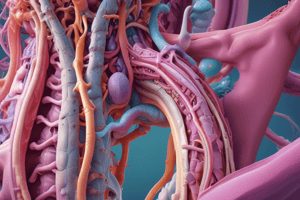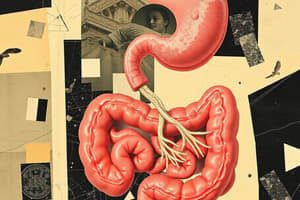Podcast
Questions and Answers
What is the role of serotonin in the gastrointestinal system?
What is the role of serotonin in the gastrointestinal system?
- Secretes NO and VIP for relaxation of smooth muscles
- Causes smooth muscle contraction behind the bolus
- Activates sensory neurons that activate the myenteric plexus (correct)
- Promotes a motility pattern related to peristalsis
Which neurotransmitter leads to smooth muscle contraction behind the bolus?
Which neurotransmitter leads to smooth muscle contraction behind the bolus?
- Acetylcholine
- Substance P (correct)
- Vasoactive Intestinal Polypeptide (VIP)
- Nitric Oxide (NO)
What is the purpose of segmentation in the gastrointestinal system?
What is the purpose of segmentation in the gastrointestinal system?
- To produce relaxation ahead of the bolus
- To enhance absorption of chyme (correct)
- To force chyme both backward and forward
- To promote peristalsis
Which motility pattern involves a segment of bowel contracting at both ends?
Which motility pattern involves a segment of bowel contracting at both ends?
In segmentation, what occurs during the second contraction in a bowel segment?
In segmentation, what occurs during the second contraction in a bowel segment?
Which neurotransmitter is responsible for relaxation ahead of the stimulus in the gastrointestinal system?
Which neurotransmitter is responsible for relaxation ahead of the stimulus in the gastrointestinal system?
What is constipation defined as?
What is constipation defined as?
What contributes to the symptom generation in chronic constipation according to recent findings?
What contributes to the symptom generation in chronic constipation according to recent findings?
How often do many normal humans defecate based on the text?
How often do many normal humans defecate based on the text?
What symptoms are caused by constipation according to the text?
What symptoms are caused by constipation according to the text?
How much of the small colored beads fed with a meal are recovered in the stool in 72 hours on average?
How much of the small colored beads fed with a meal are recovered in the stool in 72 hours on average?
What technology can be used to monitor transit time, pressure fluctuations, and changes in pH in the gastrointestinal tract according to the text?
What technology can be used to monitor transit time, pressure fluctuations, and changes in pH in the gastrointestinal tract according to the text?
What can provoke hypovolemia and hypotension in the intestine?
What can provoke hypovolemia and hypotension in the intestine?
Which action helps prevent the aspiration of vomitus into the trachea during vomiting?
Which action helps prevent the aspiration of vomitus into the trachea during vomiting?
What initiates the process of vomiting?
What initiates the process of vomiting?
What role does reverse peristalsis play in vomiting?
What role does reverse peristalsis play in vomiting?
Which factor is NOT mentioned as a cause for dumping syndrome?
Which factor is NOT mentioned as a cause for dumping syndrome?
How does vomiting exemplify central regulation of gut motility functions?
How does vomiting exemplify central regulation of gut motility functions?
What is the role of erythromycin in treating patients with decreased gastrointestinal motility?
What is the role of erythromycin in treating patients with decreased gastrointestinal motility?
Which part of the stomach relaxes and accommodates food with little to no pressure increase during the receptive relaxation phase?
Which part of the stomach relaxes and accommodates food with little to no pressure increase during the receptive relaxation phase?
What initiates peristalsis in the lower portion of the stomach during gastric motility?
What initiates peristalsis in the lower portion of the stomach during gastric motility?
What is the term used to describe the contraction of the distal stomach caused by each peristaltic wave?
What is the term used to describe the contraction of the distal stomach caused by each peristaltic wave?
How many times do peristaltic waves occur per minute in the regulation of gastric emptying?
How many times do peristaltic waves occur per minute in the regulation of gastric emptying?
Which parts of the gastrointestinal system apparently function as a unit in regulating gastric emptying?
Which parts of the gastrointestinal system apparently function as a unit in regulating gastric emptying?
What initiates the large peristaltic wave that sweeps through the intestine in between meals?
What initiates the large peristaltic wave that sweeps through the intestine in between meals?
What helps in preventing reflux of gastric contents into the esophagus?
What helps in preventing reflux of gastric contents into the esophagus?
What is responsible for the rhythmic fluctuations in the membrane potential of gastrointestinal smooth muscle?
What is responsible for the rhythmic fluctuations in the membrane potential of gastrointestinal smooth muscle?
What process allows the stomach to accommodate a meal without significant pressure increase?
What process allows the stomach to accommodate a meal without significant pressure increase?
What is the role of peristaltic wave in the esophagus during swallowing?
What is the role of peristaltic wave in the esophagus during swallowing?
Which cells establish the basic electrical rhythm in gastrointestinal smooth muscle?
Which cells establish the basic electrical rhythm in gastrointestinal smooth muscle?
What is the primary function of the gastrointestinal motility discussed in the text?
What is the primary function of the gastrointestinal motility discussed in the text?
Which segment of the gastrointestinal tract has the longest length as per the measurements mentioned in the text?
Which segment of the gastrointestinal tract has the longest length as per the measurements mentioned in the text?
What is the main function of the migrating motor complex in the gastrointestinal system?
What is the main function of the migrating motor complex in the gastrointestinal system?
In terms of motility patterns, what distinguishes segmentation from peristalsis?
In terms of motility patterns, what distinguishes segmentation from peristalsis?
What is the significance of basic electrical activity in regulating gastrointestinal motility?
What is the significance of basic electrical activity in regulating gastrointestinal motility?
How does receptive relaxation in the stomach contribute to its function?
How does receptive relaxation in the stomach contribute to its function?
What initiates peristalsis in the gastrointestinal tract?
What initiates peristalsis in the gastrointestinal tract?
What is the rate range at which the contents of the lumen are propelled during peristaltic activity?
What is the rate range at which the contents of the lumen are propelled during peristaltic activity?
What effect does extrinsic innervation have on peristalsis?
What effect does extrinsic innervation have on peristalsis?
Which action blocks the progression of contents in the gastrointestinal tract during peristalsis?
Which action blocks the progression of contents in the gastrointestinal tract during peristalsis?
What term is used to describe the reflex response that involves circular contraction behind a stimulus and an area of relaxation in front of it?
What term is used to describe the reflex response that involves circular contraction behind a stimulus and an area of relaxation in front of it?
Which system is an excellent example of the integrated activity during peristalsis?
Which system is an excellent example of the integrated activity during peristalsis?
Which neurotransmitter decreases the number of spikes and tension in smooth muscle in the gastrointestinal system?
Which neurotransmitter decreases the number of spikes and tension in smooth muscle in the gastrointestinal system?
In the distal ileum, what is the approximate rate of the Basic Electrical Rhythm (BER) per minute?
In the distal ileum, what is the approximate rate of the Basic Electrical Rhythm (BER) per minute?
What is the function of the Basic Electrical Rhythm (BER) in the gastrointestinal system?
What is the function of the Basic Electrical Rhythm (BER) in the gastrointestinal system?
What happens to peristalsis in the stomach after vagotomy or transection of the stomach wall?
What happens to peristalsis in the stomach after vagotomy or transection of the stomach wall?
What does the Migrating Motor Complex involve during periods of fasting in the gastrointestinal system?
What does the Migrating Motor Complex involve during periods of fasting in the gastrointestinal system?
What effect does acetylcholine have on smooth muscle in the gastrointestinal system?
What effect does acetylcholine have on smooth muscle in the gastrointestinal system?
What type of smooth muscle contractions in the small intestine move the chyme to and from, increasing its exposure to the mucosal surface?
What type of smooth muscle contractions in the small intestine move the chyme to and from, increasing its exposure to the mucosal surface?
How many basic electrical rhythm cycles occur per minute in the proximal jejunum of the small intestine?
How many basic electrical rhythm cycles occur per minute in the proximal jejunum of the small intestine?
What do tonic contractions in the small intestine do?
What do tonic contractions in the small intestine do?
What is the purpose of peristalsis in the small intestine?
What is the purpose of peristalsis in the small intestine?
Why does the transit time in the small intestine become longer in the fed state compared to the fasted state?
Why does the transit time in the small intestine become longer in the fed state compared to the fasted state?
Which characteristic distinguishes segmentation contractions from peristaltic waves in the small intestine?
Which characteristic distinguishes segmentation contractions from peristaltic waves in the small intestine?
What hormone triggers the large peristaltic wave that sweeps through the intestine between meals?
What hormone triggers the large peristaltic wave that sweeps through the intestine between meals?
What is the function of interstitial cells of Cajal in the gastrointestinal system?
What is the function of interstitial cells of Cajal in the gastrointestinal system?
What is the purpose of receptive relaxation in the stomach during a meal?
What is the purpose of receptive relaxation in the stomach during a meal?
How is swallowing coordinated with peristalsis in the esophagus?
How is swallowing coordinated with peristalsis in the esophagus?
What triggers relaxation of the lower esophageal sphincter to prevent reflux?
What triggers relaxation of the lower esophageal sphincter to prevent reflux?
What is the primary function of the migrating motor complex in the gastrointestinal system?
What is the primary function of the migrating motor complex in the gastrointestinal system?
Peristalsis is a motility pattern in the gastrointestinal system where a segment of bowel contracts at both ends.
Peristalsis is a motility pattern in the gastrointestinal system where a segment of bowel contracts at both ends.
The migrating motor complex mainly functions to propel food through the stomach and small intestine.
The migrating motor complex mainly functions to propel food through the stomach and small intestine.
Vomiting is an example of central regulation of gut motility functions.
Vomiting is an example of central regulation of gut motility functions.
Receptive relaxation in the stomach leads to increased pressure during meals.
Receptive relaxation in the stomach leads to increased pressure during meals.
The basic electrical rhythm (BER) in the gastrointestinal system is primarily regulated by neurotransmitters.
The basic electrical rhythm (BER) in the gastrointestinal system is primarily regulated by neurotransmitters.
Segmentation in the gastrointestinal system involves propelling food through the length of the gastrointestinal tract.
Segmentation in the gastrointestinal system involves propelling food through the length of the gastrointestinal tract.
Peristalsis is triggered by the hormone gastrin.
Peristalsis is triggered by the hormone gastrin.
The stomach prevents an increase in pressure during meal accommodation by a process called receptive relaxation.
The stomach prevents an increase in pressure during meal accommodation by a process called receptive relaxation.
The basic electrical rhythm (BER) in the gastrointestinal smooth muscle is established by interstitial cells of Cajal.
The basic electrical rhythm (BER) in the gastrointestinal smooth muscle is established by interstitial cells of Cajal.
The migrating motor complex in the intestine primarily functions to trigger peristaltic waves after meals.
The migrating motor complex in the intestine primarily functions to trigger peristaltic waves after meals.
Swallowing is coordinated with a peristaltic wave along the length of the small intestine.
Swallowing is coordinated with a peristaltic wave along the length of the small intestine.
Relaxation of the lower esophageal sphincter occurs after the arrival of the food bolus, preventing reflux of gastric contents.
Relaxation of the lower esophageal sphincter occurs after the arrival of the food bolus, preventing reflux of gastric contents.
Erythromycin binds to motilin receptors and its derivatives are not valuable in treating patients with decreased gastrointestinal motility.
Erythromycin binds to motilin receptors and its derivatives are not valuable in treating patients with decreased gastrointestinal motility.
Receptive relaxation in the stomach is vagally mediated and triggered by the movement of the rectum and anus.
Receptive relaxation in the stomach is vagally mediated and triggered by the movement of the rectum and anus.
Peristaltic waves in the stomach occur 1-2 times per minute during gastric emptying.
Peristaltic waves in the stomach occur 1-2 times per minute during gastric emptying.
The antrum, pylorus, and lower duodenum function separately in the regulation of gastric emptying.
The antrum, pylorus, and lower duodenum function separately in the regulation of gastric emptying.
The contraction of the distal stomach caused by each peristaltic wave is known as antral diastole.
The contraction of the distal stomach caused by each peristaltic wave is known as antral diastole.
During gastric motility, peristalsis begins in the upper portion of the stomach.
During gastric motility, peristalsis begins in the upper portion of the stomach.
The migrating motor complex (MMC) consists of three phases: phase I is a period of regular activity, phase II is a quiescent period, and phase III is a burst of irregular electrical and mechanical activity.
The migrating motor complex (MMC) consists of three phases: phase I is a period of regular activity, phase II is a quiescent period, and phase III is a burst of irregular electrical and mechanical activity.
Motilin is responsible for initiating the migrating motor complex (MMC) in the gastrointestinal system.
Motilin is responsible for initiating the migrating motor complex (MMC) in the gastrointestinal system.
Gastric secretion, bile flow, and pancreatic secretion decrease during each cycle of the migrating motor complex.
Gastric secretion, bile flow, and pancreatic secretion decrease during each cycle of the migrating motor complex.
Erythromycin suppresses the release of motilin, leading to the initiation of the migrating motor complex.
Erythromycin suppresses the release of motilin, leading to the initiation of the migrating motor complex.
The migrating motor complex (MMC) is abolished when a meal is ingested and only resumes once digestion and absorption are complete.
The migrating motor complex (MMC) is abolished when a meal is ingested and only resumes once digestion and absorption are complete.
During the period of fasting, the migrating motor complex (MMC) involves a return to peristalsis and other forms of BER and spike potentials.
During the period of fasting, the migrating motor complex (MMC) involves a return to peristalsis and other forms of BER and spike potentials.
Contraction of the antrum is always followed by contraction of the duodenum.
Contraction of the antrum is always followed by contraction of the duodenum.
Solid masses are allowed to enter the duodenum without being mixed or crushed in the antrum.
Solid masses are allowed to enter the duodenum without being mixed or crushed in the antrum.
The rate at which the stomach empties into the duodenum is the same for all types of food ingested.
The rate at which the stomach empties into the duodenum is the same for all types of food ingested.
Cholecystokinin (CCK) has no effect on preventing regurgitation from the duodenum.
Cholecystokinin (CCK) has no effect on preventing regurgitation from the duodenum.
Hyperosmolality of duodenal contents has no impact on gastric emptying.
Hyperosmolality of duodenal contents has no impact on gastric emptying.
The rate of emptying into the duodenum is not influenced by the osmotic pressure of the material entering it.
The rate of emptying into the duodenum is not influenced by the osmotic pressure of the material entering it.
Lesions of the area postrema have a significant impact on the vomiting response to gastrointestinal irritation.
Lesions of the area postrema have a significant impact on the vomiting response to gastrointestinal irritation.
Serotonin released from enterochromaffin cells in the small intestine triggers vomiting through dopamine D2 receptors.
Serotonin released from enterochromaffin cells in the small intestine triggers vomiting through dopamine D2 receptors.
5-HT3 antagonists such as chlorpromazine are effective antiemetic agents.
5-HT3 antagonists such as chlorpromazine are effective antiemetic agents.
Cannabinoids play a known role in reducing the anxiety associated with chemotherapy-induced vomiting.
Cannabinoids play a known role in reducing the anxiety associated with chemotherapy-induced vomiting.
The primary function of corticosteroids in treating vomiting produced by chemotherapy is to trigger vomiting.
The primary function of corticosteroids in treating vomiting produced by chemotherapy is to trigger vomiting.
The benzodiazepines reduce the anxiety associated with chemotherapy, thus aiding in the treatment of chemotherapy-induced vomiting.
The benzodiazepines reduce the anxiety associated with chemotherapy, thus aiding in the treatment of chemotherapy-induced vomiting.
The chemoreceptor trigger zone is located in the area postrema of the midbrain.
The chemoreceptor trigger zone is located in the area postrema of the midbrain.
Impulses for vomiting can be relayed to the medulla over somatic afferent pathways in the sympathetic nerves and vagi.
Impulses for vomiting can be relayed to the medulla over somatic afferent pathways in the sympathetic nerves and vagi.
Motion sickness can be attributed to afferents from the hypothalamus nuclei.
Motion sickness can be attributed to afferents from the hypothalamus nuclei.
Emetic responses to emotionally charged stimuli occur due to afferents from the brainstem.
Emetic responses to emotionally charged stimuli occur due to afferents from the brainstem.
The chemoreceptor cells in the medulla can initiate vomiting when stimulated by circulating chemical agents.
The chemoreceptor cells in the medulla can initiate vomiting when stimulated by circulating chemical agents.
The chemoreceptor trigger zone in the medulla triggers vomiting by responding to smells and sights.
The chemoreceptor trigger zone in the medulla triggers vomiting by responding to smells and sights.
During vomiting, the glottis opens to prevent aspiration of vomitus into the trachea.
During vomiting, the glottis opens to prevent aspiration of vomitus into the trachea.
Reverse peristalsis in vomiting involves emptying material from the lower part of the small intestine into the stomach.
Reverse peristalsis in vomiting involves emptying material from the lower part of the small intestine into the stomach.
Avoiding large meals, especially those with high concentrations of simple sugars, is a recommended treatment for dumping syndrome.
Avoiding large meals, especially those with high concentrations of simple sugars, is a recommended treatment for dumping syndrome.
Peristalsis in the stomach always occurs at a rate of 1-2 times per minute during gastric emptying.
Peristalsis in the stomach always occurs at a rate of 1-2 times per minute during gastric emptying.
The Migrating Motor Complex (MMC) is activated during fasting periods and functions to trigger peristaltic waves after meals.
The Migrating Motor Complex (MMC) is activated during fasting periods and functions to trigger peristaltic waves after meals.
Vomiting is an example of peripheral regulation of gut motility functions.
Vomiting is an example of peripheral regulation of gut motility functions.
Peristalsis in the intestine is triggered by the hormone gastrin.
Peristalsis in the intestine is triggered by the hormone gastrin.
The lower esophageal sphincter relaxes after the food bolus has already arrived in the stomach.
The lower esophageal sphincter relaxes after the food bolus has already arrived in the stomach.
Smooth muscle contractions behind the food bolus are primarily initiated by spike potentials.
Smooth muscle contractions behind the food bolus are primarily initiated by spike potentials.
The migrating motor complex in the intestine serves a primarily digestive function.
The migrating motor complex in the intestine serves a primarily digestive function.
Receptive relaxation in the stomach allows for a decrease in volume without a significant increase in pressure.
Receptive relaxation in the stomach allows for a decrease in volume without a significant increase in pressure.
Contractions of the antrum always precede contractions of the duodenum during peristalsis.
Contractions of the antrum always precede contractions of the duodenum during peristalsis.
Most cases of constipation can be relieved by a change in diet to include less fiber.
Most cases of constipation can be relieved by a change in diet to include less fiber.
Lubiprostone acts by enhancing chloride secretion into the colon, leading to increased fluidity of colonic contents.
Lubiprostone acts by enhancing chloride secretion into the colon, leading to increased fluidity of colonic contents.
Peristalsis and segmentation are two major patterns of motility in the gastrointestinal system that serve to propel or mix the luminal contents, respectively.
Peristalsis and segmentation are two major patterns of motility in the gastrointestinal system that serve to propel or mix the luminal contents, respectively.
Receptive relaxation in the stomach is caused by movement of the rectum and anus.
Receptive relaxation in the stomach is caused by movement of the rectum and anus.
Gastric secretion, bile flow, and pancreatic secretion increase during each cycle of the migrating motor complex.
Gastric secretion, bile flow, and pancreatic secretion increase during each cycle of the migrating motor complex.
Solid masses are allowed to enter the duodenum without being mixed or crushed in the antrum.
Solid masses are allowed to enter the duodenum without being mixed or crushed in the antrum.
Flashcards are hidden until you start studying





